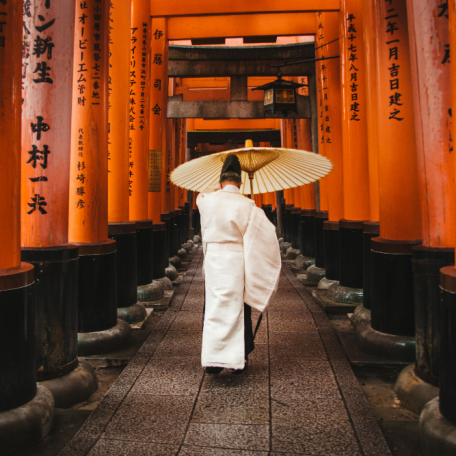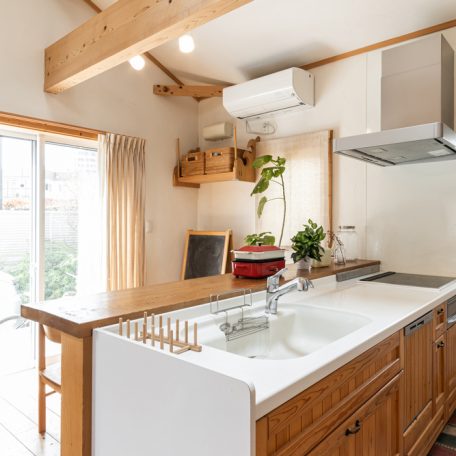TEXTURE OF FOOD THROUGH SOUND: JAPANESE ONOMATOPOEIA
Sep 30, 2024
BY Chisato Takahashi

Do you all know what onomatopoeia is? Onomatopoeia is a way of expressing the things that don’t make sound, such as states, actions, appearances, voices, sounds, textures, and emotions. Words like “woof woof” representing animal sounds are also the same. Interestingly, Japan has many onomatopoeic words compared to other languages, which can also express various emotions and situations. Since onomatopoeic words are simple and easy, they can immediately convey a situation to the listener. For example, between “Nodo ga kawaita” and “Nodo ga Karakara,” (I’m thirsty) which sentence leaves a stronger impression?
In general, “Karakara” expresses dryness, emptiness, or the sound of two things hitting each other. It usually works like this: “The ground is dry – the ground is karakara,” “This wallet is empty – this wallet is karakara,” or “There’s something in that can making a sound – the can sounds like karakara.” Using onomatopoeia like this can make sentences shorter and more memorable. In my opinion, people who like manga and anime will be confused by how many onomatopoeic words are used in Japan. However, onomatopoeia is very important in Japanese culture and it can be “a magic word” in a sentence when we use it effectively.

Onomatopoeia Examples – Photo Credit: Chisato by canva
Why Do Japanese People Often Use Onomatopoeia?
As I mentioned before, Japan uses a lot of onomatopoeia, but it’s not only onomatopoeia. Japanese people used to cherish the seasonal words “kigo” and “haiku” as a way to appeal to emotions and enrich expressions. In Haiku and Kigo, you often see the sounds of insects, and this is because Japanese people see these natural sounds not as noise, but as beautiful voices and words.
The human brain is divided into the right and left hemispheres with the right hemisphere, known as the music brain, processing music, and noise, while the left hemisphere, known as the language brain, handles logical and intellectual processes. Interesting studies have shown that only Japanese and Polynesian people unconsciously listen to the sounds of insects with the language part of their brains. On the other hand, Western people including Chinese and Koreans tend to listen to insect sounds, as well as waves, wind, and rain with the right brain, treating it just like noise.

A rainy evening in Tokyo – Photo Credit: aiyoshi597
As a result, English simply describes the various types of rain as a drizzle, shower, downpour, etc, However, the Japanese also remember rain as onomatopoeia sounds, such as “potsu potsu,” “shito shito,” “para para,” and “zaa zaa.” Enjoying the sound of rain, and the voices of insects, finding a connection with nature in daily life, and creating sensory experiences symbolize the depth and complexity of Japanese culture. Isn’t it amazing how Japanese people delicately express even the smallest things in nature? If you like the romanticism of Japanese culture, make sure to check out this article too! In this blog, I am going to introduce more about Japanese onomatopoeia, focusing on food.

Gari Gari-kun – Photo Credit: matsuemoon
Why Are Japanese Onomatopoeia So Common In Food?
In Japan, many onomatopoeic words express food textures, and they are often used in business. This is because food and onomatopoeia go well together, and using them effectively can lead to increased sales. For example, have you ever tried “Gari Gari-kun,” Japanese ice cream? “Gari Gari-kun,” literally “Mr. Crunchy,” is made of shaved ice, with the name inspired by the sound of biting into ice. Just by hearing the name of the product, Japanese people can easily understand that “this ice cream has a crunchy texture like shaved ice.” If an ice cream is written “Pari Pari,” we understand that “the surface is crispy with chocolate or dough.”

Food Onomatopoeia – Photo Credit: Chisato via canva
Usually, Japanese onomatopoeia repeats the same word twice, making it friendly and easy to remember. Additionally, using voiced sounds can make a stronger impact, and “Gari Gari-kun” is a good example of this. But why do voice sounds stand out? The reason is that onomatopoeic words with voiced sounds often have negative or powerful images. For instance, “Sara Sara” hair gives the impression of soft and flowing hair. On the other hand, “Zara Zara” hair is likely to describe dry and damaged hair. Furthermore, “Kira Kira” stars are beautifully shining stars, while the “Gira Gira” sun sounds like intense and dazzling light. By using onomatopoeia, it becomes easier to imagine food textures, adds strength to the expression in advertisements, and motivates customers to buy.

Kari kari & Saku saku Katsu – Photo Credit: Yoav Aziz
32 Food Onomatopoeia Examples In Japan
- サクサク (Saku saku)/crispy – Food that makes a good crunchy sound when bitten into.
- シャキシャキ (Shaki Shaki)/crispy – Fresh vegetables with a crunchy texture, like lettuce.
- シャリシャリ (Shari shari)/crispy – Textured like sherbet or shaved ice.
- ジャリジャリ (Jari jari)/gritty – Negative expression of “Shari shari,” like sand in scallops.
- カリカリ (Kari kari)/crunchy – A texture slightly harder than crispy, like senbei (rice crackers).
- ガリガリ (Gari gari)/crunchy – An emphasized version of “Kari kari.”
- コリコリ(Kori kori)/crunchy – Hard texture, like pig’s ears.
- ゴロゴロ (Goro goro)/chunky – Food cut into large pieces, like chopped vegetables.
- プチプチ (Puchi puchi) & つぶつぶ (Tsubu tsubu)/pulpy – Food with small bits, like caviar or strawberry seeds.
- アツアツ (Atsu atsu)/hot – Hot food.
- ギトギト (Gito gito)/greasy – Oily texture.
- サラサラ (Sara sara)/smooth – Easy-to-drink liquids.
- ザラザラ (Zara zara)/grainy – A rough surface, like Japanese pears.
- シュワシュワ (Shuwa shuwa)/ fizzy – Sparkling drinks that pop in your mouth.
- ジュワジュワ (Juwa juwa)/fizzy – Stronger than “Shuwa shuwa.”
- ツルツル (Tsuru tsuru) & トゥルントゥルン (Turunn turunn)/smooth – A smooth texture, like noodles that is easy to swallow.
- トロトロ (Toro toro)/melty – Food that melts easily.
- ドロドロ (Doro doro)/mushy – More melted than “Toro toro.”
- グニュグニュ (Gunyu gunyu)/squishy – Soft and unpleasant texture, like seaweed.
- ヌルヌル (Nuru nuru)/slimy – Slimy things, like fish or spoiled meat.
- ネバネバ (Neba neba)/slimy – Slimy food, like natto or okra.
- ねちょねちょ (Necho necho) & ベチャベチャ (Becha becha) & ベトベト (Beto beto)/watery – Food with too much moisture, like soggy rice.
- パサパサ (Pasa pasa) & モサモサ (Mosa mosa)/dry – Dry food like overcooked chicken.
- パラパラ (Para para)/not sticky – Food that doesn’t stick together, like fried rice.
- パリパリ (Pari pari)/crispy – Food that breaks easily, like thin chocolate.
- ピリピリ (Piri piri)/tingly – Food that makes your tongue tingle from the spiciness.
- ビリビリ (Biri biri)/numb – A stronger version of “Piri Piri.”
- プリプリ (Puri puri)/plump – Juicy and elastic food, like shrimp or sausages.
- プルプル (Puru puru) & プルンプルン (Purun purun)/jiggly – Jiggly and soft food, like jelly.
- ホクホク (Hoku hoku) & ほかほか (Hoka hoka)/warm – Warm food.
- ふわふわ (Fuwa fuwa)/fluffy – Soft and light food, like marshmallows.
- もちもち (Mochi mochi)/sticky – Sticky and elastic food, like mochi.

Atsu Atsu no Takoyaki – Photo Credit:フリー素材ぱくたそ
Did you understand these onomatopoeic words? In Japan, onomatopoeia plays a crucial role in expressing the texture and sensation of food. Moreover, using them in marketing helps convey product uniqueness and attract customer interest effectively. This delicate language not only adds depth and charm to the cuisine but also represents interesting culture.
I often argue with friends about whether dog barks sound like “Wann wann” or “woof woof.” Perhaps the Japanese hear “Wann wann” because they process dog barks linguistically in the left brain. Finally, I understand why opinions differed so much on this… Please cherish everyday sounds and experiences, savoring them slowly as it might expand your worldview. Furthermore, if you hear dog barks as “Wann wann” in the future, I would say that you’ve perfectly mastered the Japanese language and culture at a C2 level. By trying to listen to the word in a way you hadn’t previously thought to do so you are allowing yourself to experience reality in a brand new way. In this blog, we talked mostly about food, but there are many other sound words to explore, so be sure to check them out!
Featured Photo Credit: Chisato via canva
What better way to remember these new onomatopoeia than through eating the delicious food they’re associated with? Come join one of our food tours in Tokyo, Kyoto, and Osaka.
Book your pocket wifi now to stay connected through your entire Japan Journey!

Be sure to get the JR Pass to make navigating Japan during your trip that much easier!

YOU MIGHT ALSO LIKE




